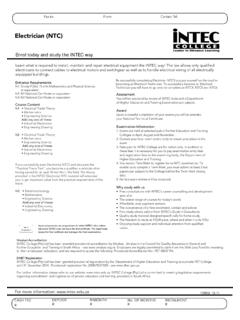Transcription of Electrician.s Tricks of the Trade - Columbus Ohio …
1 1 electrician s Tricks of the Trade Use wirenut to correct threads: To correct messed up threads on all-thread, take a red wirenut on 1/4-20 thread, screw it on tight then unscrew. The threads will now be like new. Use a blue wirenut on 3/8-16 thread. Amps. By Multiplication: Dividing shortcut, Hey if your like me, when you re trying to figure out how many amps. a piece of Equipment draws, long division is a hassle and I usually get it wrong, but multiplying is a lot easier. Well with this shortcut you can use multiplication instead of division to divide watts by volts. Example: usual way to figure how many amps. in 5000 watts with a voltage of 120 volts is to divide 5000/120= amps. Shortcut : You multiply the watts 5000 by the reciprocal of 120 which will give you the same answer as dividing. The reciprocals for these voltages are 120=.008333 208=.004807 230=.004347 277=.003610 480=.002083 Shortcut Example: watts x reciprocal=amps 5000 x.
2 008333= 5000 x .004807= 5000 x .004347= 5000 x .003610= 5000 x .002083= By the way to get the reciprocal of a number divide 1 by the number you want the reciprocal of the result is the reciprocal Anti-itch Remedy For Insulation: How often do you have to work in an attack or lay in ceiling that has insulation? Well, there is a remedy that will keep the itch a way. Take a bottle of baby powder or corn starch and apply it to your hands, arms, neck and a face (be carefull not to get in your eyes). The powder protects your skin from the insulation and prevents the irritation and itching Locating Locations In Attic With Ease: After your customer decides where they want the new devices installed in existing drywalls, you can drill (or nail) a 1/8 hole at these locations into the attic (or floor), push a bare #14 CU about 3 feet long into the 1/8 hole then go into the attic or crawl space and locate where you want to drill the hole.
3 The shinny copper wire is really visible with flashlight in dark attics or crawlspaces. Use a Ballon to Plug Unused Conduits: An inexpensive way to plug unused conduits is to use a balloon and spray foam. First the balloons were blown up to fit the conduit snugly and then the balloon was pushed about 6 inches back into the conduit and then filled with foam. The conduits can be opened easily for future use. 2 90 Bends Simplified: When bending a 90 bend on a sidewall or a chicago bender and you do not do the deduction for that size pipe. Try Let's say you need a 36 90 on a piece of 2 inch conduit. Put a mark at 36 inches and then deduct the size pipe., which is 2 inches and put a mark there. Now put the pipe into the bender and take a level and line up the back of the shoe, on the lip (not in the shoe) with your mark and bend. You will now have a 36 90 without having to know the deduction. This trick works with all sizes.
4 Just make sure you put your level on the lip of the shoe not inside the shoe. Use Bender To Bend PVC: You can bend PVC pipe with a bender also! I have found that if you bend it to 90 degrees you will get a 45. It seems to work out pretty close to half of the degrees you bend it at. You will have to make 2 bends to get a 90 but it is MUCH FASTER than heating the pipe! I haven't tried it on any pipe larger than 1 inch but I would guess that as the pipe gets bigger, the maximum degrees that you would be able to use this method would decrease. Another handy way is to find something that resembles the degrees you want and lay the pipe on it and let the sun COOK it if you have time before it needs to be installed. Anything to make life easier since we are such HARD WORKERS! How to repair bent/kinked fish tape: Every wireman and contractor has struggled with a bent or kinked fishtape. Often, the damaged tape is discarded, and a new one purchased.
5 The next time you are faced with this problem, try the following: Drive 8 or 10 16- or 20-penny nail in a straight line into a block of wood, at least 12 long, a post or anything that can be secured. The nail should be about 3/4 to 1 apart. Next, unwind the fish tape completely and weave it through the nails at the reel end. Now, pull the length of the fish tape through the nails. It may be necessary to repeat the steps two to three times until it is bent/kink free. Drywall Biscuits For Old Work: When we need to notch a stud or fireblock to run flex/Romex in a wall, we use the hole saws to cut down on the mess and to make the repair easier later. Find the center of the stud. Drill through the drywall with a 3 hole saw, and save the round biscuit for patching later. Don't drill out the stud yet. Switch to a 1 1/2 (EMT size) hole saw and plunge drill the stud far enough to get your flex/Romex in. Knock out the round wooden plug with a chisel.
6 The 3 biscuit opening should give you enough room reach in and fish your wire from stud cavity to stud cavity. Once you get your wire in, nail a Dottie plate over the notch you have made and glue the drywall biscuit back in. How To Keep Blueprints Wrinkle-Free: Cut a scrap piece of 2 or 2 1/2 pVC conduit a few inches longer than your blueprint, make and fasten a wooden plug in one end using three screws, and smooth the other end with sandpaper. Now you can keep your blueprints behind the seat or in the gangbox without their getting wrinkled or torn. Installing box supports in a double sheetrock wall: When installing a cut-in-box in double sheetrock wall, you will find that the box supports or to short to reach inside the box like they are intended to. So to make to box supports work correctly take a flat screwdriver or a small chisel and beat out the back layer of sheetrock on the top and bottom of your hole. Take out as much sheetrock that you can with out effecting the front layer.
7 Now you can insert your box supports and they will now be long enough to reach the inside of the box. There are a few apprentices out there they do not know this. 3 Use Paper To Catch Debris: When cutting boxes in sheetrock walls of finished rooms, take a couple sheets of paper and lay them on the floor in front of the wall you will be cutting in. This will keep the sheetrock dust and debris off the carpet. Leave paper down until your are completley done with your installation. Then just pick up paper slowly and discard it. This will keep your customer very happy and make you have very little clean up. Use Ceiling Grid Wire to Fish Walls: If you have to fish flex down insulated walls, all you need is some metal wire(preferably ceiling grid wire). You take the wire and bend one end into a hook, then you wrap the wire around the flex that you are pulling. These are great tools to have, no tape or stripping needed. When you're finished you unscrew the tool and re-use.
8 I hope this makes someones life a little easier. Removing 'Chico' with Ease: To remove hardened chico from a seal off to re-pull a circuit use common household vinegar. It will soften the chico so it can be removed. Chipboard Tongues Makes Great Snake: Found on most building sites the tongue is used to join the flooring together most lengths are 4 meters long they are great to push up wall to snake cables down or up they can be drilled through on the to make a hole to attach cables and can be bent to go around corners (little trick when pushing tongue up the wall and it gets stuck spin the tongue around and it will twist push up and it will most time go around the obstruction. Use Tape Measure to find Circuit Color: If anyone is like me you don't always know what color a circuit should be. If you take your tape out and look up the circuit numer it will show you. On low voltage 1-2 is black,3-4 is red, 5-6 is blue and then it repeats.)
9 Example, for circuit number 37, slide the tape out and on the 37 inch mark you will see it is 3ft 1in, then you know that the circuit color is black. I hope this helps. Using duct tape to keep boxes clean: When pre-making boxes and stubs to be installed in block walls, employ the following method. After the first conduit stub is installed into the appropriate mason mud box, cover the entire opening with duct tape. Then, write the height at which the specific box is to be installed and the device that goes into that box on the face of the opening. This makes it easier to complete the installations later and ensures that the boxes and screw holes remain mortar free. When it is time to pull wire, simply cut the tape in a X pattern. This allows you to enter the wires into the box, while providing protection from paint. Use duct tape to remove adhesive: One of the chief obstacles to a finishing touch for an installation is the easy-peel sticker - the list features plastered to the oven door, or the cleaning instructions on the light fixture lens.
10 Often the paper comes off, leaving rubbery adhesive behind, looking terrible. To save customer aggravation, firmly press a piece of duct tape onto the stickum, and peel it off. The adhesive usually comes off with the duct tape, leaving a spotless installation. Necessary Tool for Clean-up: Buy a cheap 2 wide paintbrush and carry it in your tool pouch. It comes in real handy when cleaning dust and metal shavings out of panels and boxes. That is all well and good, but one would be well advised to use electrical tape to cover the metal used to crimp the brushes to the handle, just in 4 Use a Cloth Bag For Photocell Test: A small dark cloth bag w/drawstring can be used to test photocells, save your tape and time. A royal crown bag works for me. Chipboard Tongues Makes Great Snake: Found on most building sites the tongue is used to join the flooring together most lengths are 4 meters long they are great to push up wall to snake cables down or up they can be drilled through on the to make a hole to attach cables and can be bent to go around corners (little trick when pushing tongue up the wall and it gets stuck spin the tongue around and it will twist push up and it will most time go around the obstruction.)












